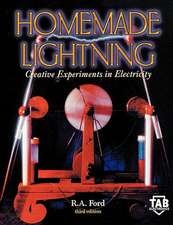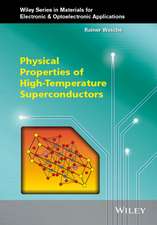Semiconducting and Metallic Polymers: Oxford Graduate Texts
Autor Alan J. Heeger, Niyazi Serdar Sariciftci, Ebinazar B. Namdasen Limba Engleză Hardback – 29 iul 2010
Din seria Oxford Graduate Texts
- 16%
 Preț: 734.52 lei
Preț: 734.52 lei - 8%
 Preț: 289.57 lei
Preț: 289.57 lei - 18%
 Preț: 511.25 lei
Preț: 511.25 lei - 18%
 Preț: 338.95 lei
Preț: 338.95 lei - 8%
 Preț: 322.49 lei
Preț: 322.49 lei - 6%
 Preț: 337.03 lei
Preț: 337.03 lei - 8%
 Preț: 255.35 lei
Preț: 255.35 lei - 13%
 Preț: 476.30 lei
Preț: 476.30 lei - 10%
 Preț: 246.84 lei
Preț: 246.84 lei - 8%
 Preț: 324.70 lei
Preț: 324.70 lei - 6%
 Preț: 312.46 lei
Preț: 312.46 lei -
 Preț: 312.07 lei
Preț: 312.07 lei - 29%
 Preț: 570.98 lei
Preț: 570.98 lei - 14%
 Preț: 500.83 lei
Preț: 500.83 lei - 8%
 Preț: 575.64 lei
Preț: 575.64 lei - 12%
 Preț: 483.51 lei
Preț: 483.51 lei - 20%
 Preț: 515.39 lei
Preț: 515.39 lei - 13%
 Preț: 291.53 lei
Preț: 291.53 lei - 9%
 Preț: 252.30 lei
Preț: 252.30 lei - 16%
 Preț: 432.56 lei
Preț: 432.56 lei -
 Preț: 307.25 lei
Preț: 307.25 lei - 16%
 Preț: 514.51 lei
Preț: 514.51 lei -
 Preț: 325.70 lei
Preț: 325.70 lei - 30%
 Preț: 638.98 lei
Preț: 638.98 lei - 15%
 Preț: 570.20 lei
Preț: 570.20 lei - 13%
 Preț: 364.82 lei
Preț: 364.82 lei - 15%
 Preț: 539.43 lei
Preț: 539.43 lei - 19%
 Preț: 445.59 lei
Preț: 445.59 lei - 14%
 Preț: 501.10 lei
Preț: 501.10 lei - 18%
 Preț: 334.57 lei
Preț: 334.57 lei - 11%
 Preț: 639.10 lei
Preț: 639.10 lei - 12%
 Preț: 323.61 lei
Preț: 323.61 lei - 28%
 Preț: 689.30 lei
Preț: 689.30 lei - 8%
 Preț: 239.80 lei
Preț: 239.80 lei - 28%
 Preț: 638.42 lei
Preț: 638.42 lei - 18%
 Preț: 496.00 lei
Preț: 496.00 lei - 17%
 Preț: 509.94 lei
Preț: 509.94 lei - 15%
 Preț: 529.91 lei
Preț: 529.91 lei - 15%
 Preț: 573.87 lei
Preț: 573.87 lei - 15%
 Preț: 590.42 lei
Preț: 590.42 lei - 20%
 Preț: 538.22 lei
Preț: 538.22 lei - 17%
 Preț: 408.22 lei
Preț: 408.22 lei
Preț: 514.66 lei
Preț vechi: 653.60 lei
-21% Nou
Puncte Express: 772
Preț estimativ în valută:
98.49€ • 101.75$ • 81.93£
98.49€ • 101.75$ • 81.93£
Carte tipărită la comandă
Livrare economică 10-15 martie
Preluare comenzi: 021 569.72.76
Specificații
ISBN-13: 9780198528647
ISBN-10: 0198528647
Pagini: 290
Ilustrații: 250 b/w line and halftone illustrations
Dimensiuni: 176 x 249 x 20 mm
Greutate: 0.74 kg
Editura: OUP OXFORD
Colecția OUP Oxford
Seria Oxford Graduate Texts
Locul publicării:Oxford, United Kingdom
ISBN-10: 0198528647
Pagini: 290
Ilustrații: 250 b/w line and halftone illustrations
Dimensiuni: 176 x 249 x 20 mm
Greutate: 0.74 kg
Editura: OUP OXFORD
Colecția OUP Oxford
Seria Oxford Graduate Texts
Locul publicării:Oxford, United Kingdom
Recenzii
Semiconducting and Metallic Polymers is an elegant introduction to the electronic properties of conducting (and semiconducting) polymers. The first half of the book provides a comprehensive, but straightforward, introduction to the optical and conduction properties of most commonly used polymers. The authors always discuss things with an eye to potential and current applications and the second half of the book is dedicated to the use of polymers in semiconducting device applications. This covers the now technologically very important areas of LEDs (Light Emitting Diodes), photodetectors and photovoltaic cells and field effect transistors.
Notă biografică
Alan J. Heeger won the 2000 Nobel Prize in Chemistry for the discovery and development of conductive polymers. He began his research career at the Universoty of Pennsylvania, and has been a Professor at the University of California, Santa Barbara, since 1982. Since 1988 he has also been Adjunct Professor of Physics, The University of Utah, and has been Chief Scientist, UNIAX Corporation since 1999. In 2005 he became the Director of the Heeger Center for Advanced Materials, Gwangju Institute of Science and Technology, Korea. He has won numerous awards and honours for his work.Niyazi Serdar Sariciftci worked with Alan Heeger at the Institute for Polymers & Organic Solids, University of California between 1992 and 1996. He has since been a Professor, then Chair, at the Institute for Physical Chemistry at the Johannes Kepler University in Linz, Austria, and is founding director of Linz Institute for Organic Solar Cells (LIOS). In 2005 he was elected a Fellow of the the Royal Society of Chemistry (UK).Dr. Ebinazar Namdas has a Ph.D. in Physics and is a Lecturer at the Centre for Organic Photonics & Electronics at the University of Queensland (UQ), Australia. He has more than 10 years of research experience in the opto-electronic properties of organic semiconductors. Prior to joining UQ, Dr. Namdas was a Senior Researcher at the University of California, Santa Barbara, USA.





